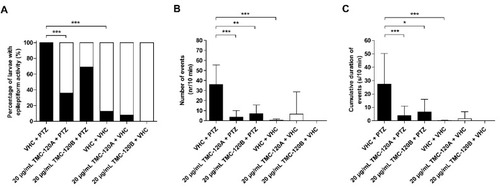Figure 7
- ID
- ZDB-FIG-191230-1750
- Publication
- Copmans et al., 2019 - Zebrafish-Based Discovery of Antiseizure Compounds from the North Sea: Isoquinoline Alkaloids TMC-120A and TMC-120B
- Other Figures
- All Figure Page
- Back to All Figure Page
|
Electrophysiological antiseizure analysis of TMC-120A and TMC-120B in the zebrafish PTZ seizure model. Noninvasive local field potential recordings from the optic tectum of larvae pre-exposed to vehicle (VHC) and pentylenetetrazole (PTZ), VHC only, compound and PTZ, or compound and VHC. Larvae were incubated with 20 µg/mL TMC-120A or TMC-120B for 2 h, conform with the maximum tolerated concentrations and incubation time used in the behavioral assay. Larvae are considered to possess epileptiform brain activity when three or more epileptiform events occurred during a 10-min recording ( |

